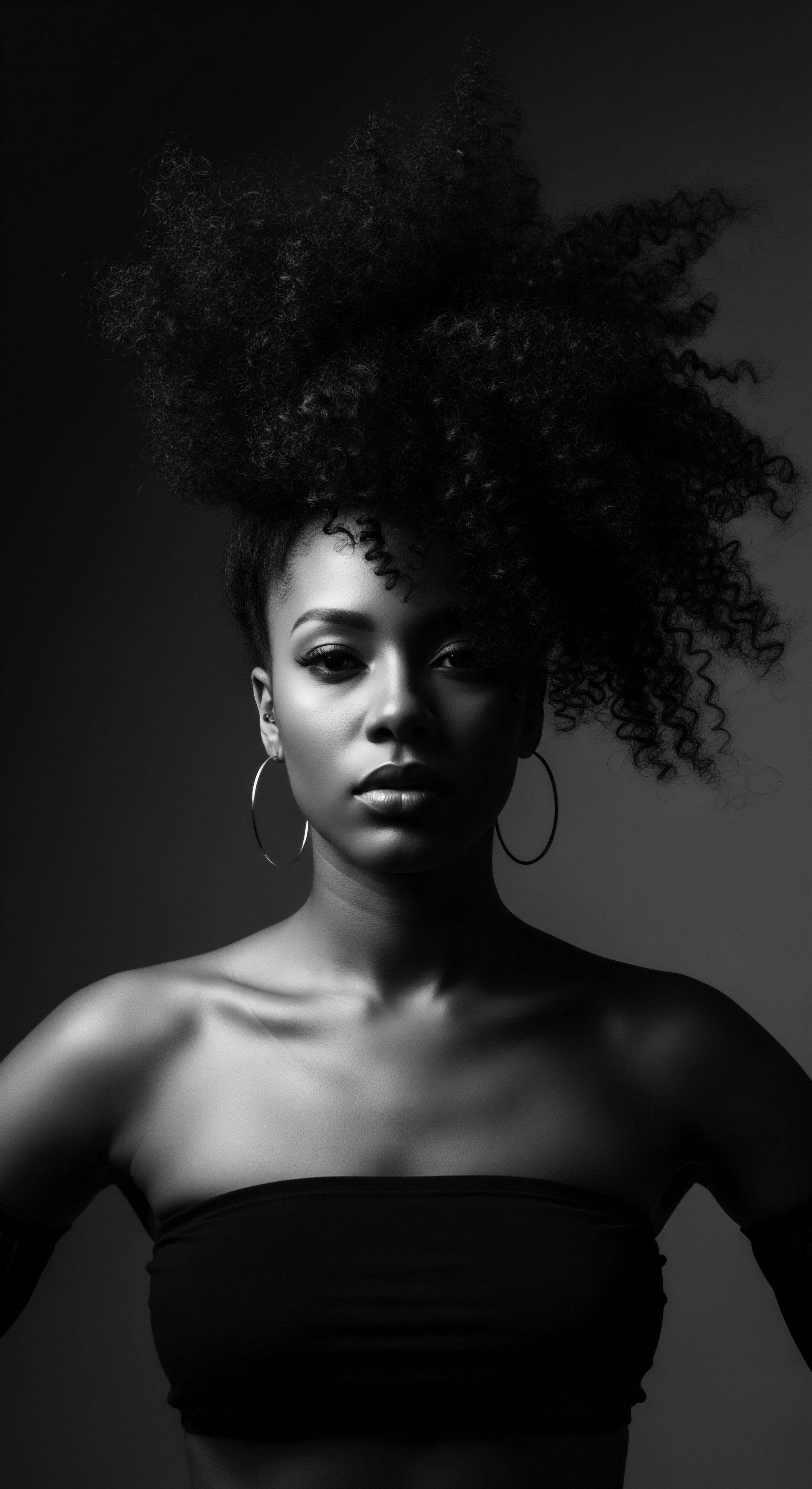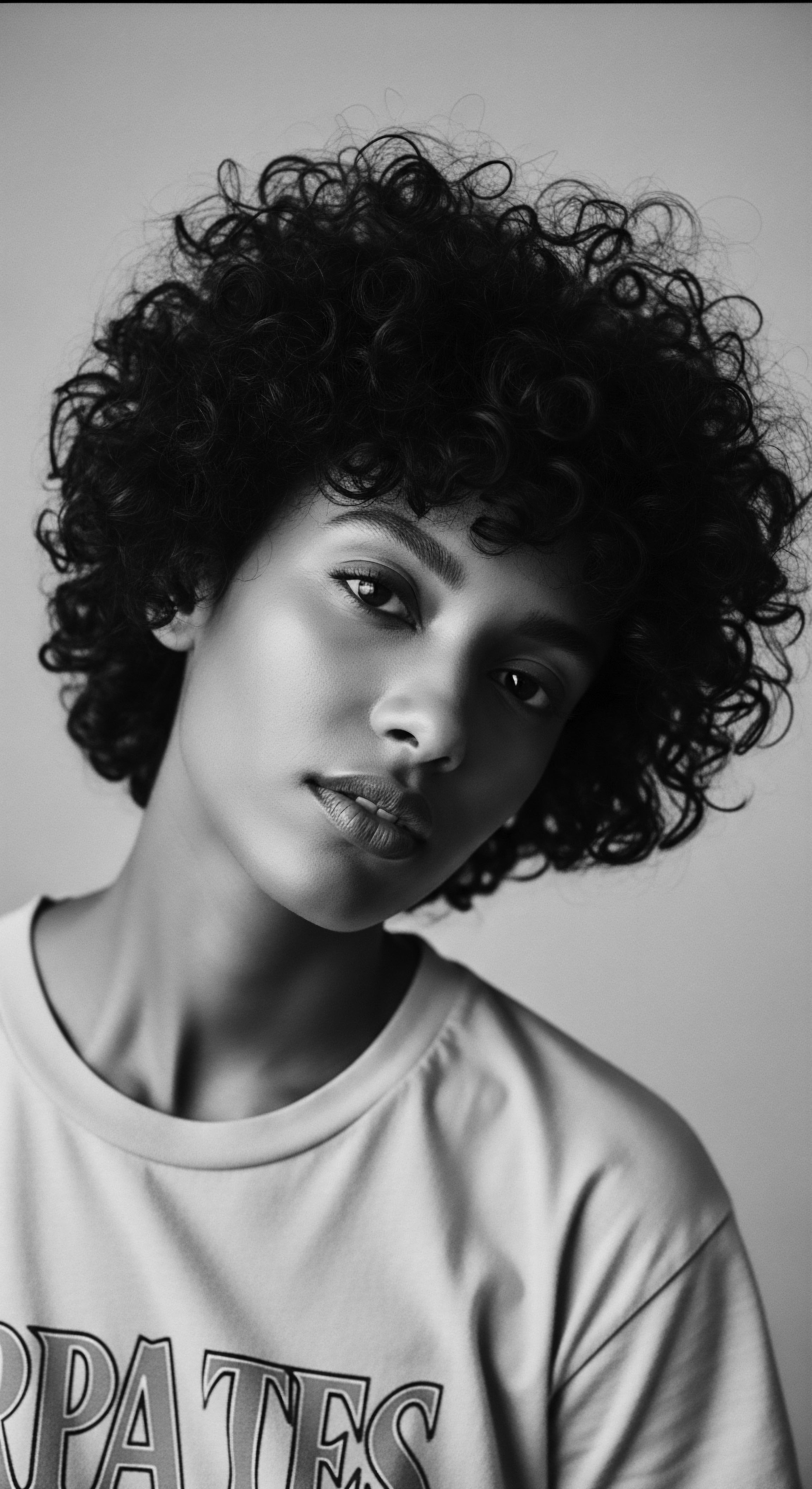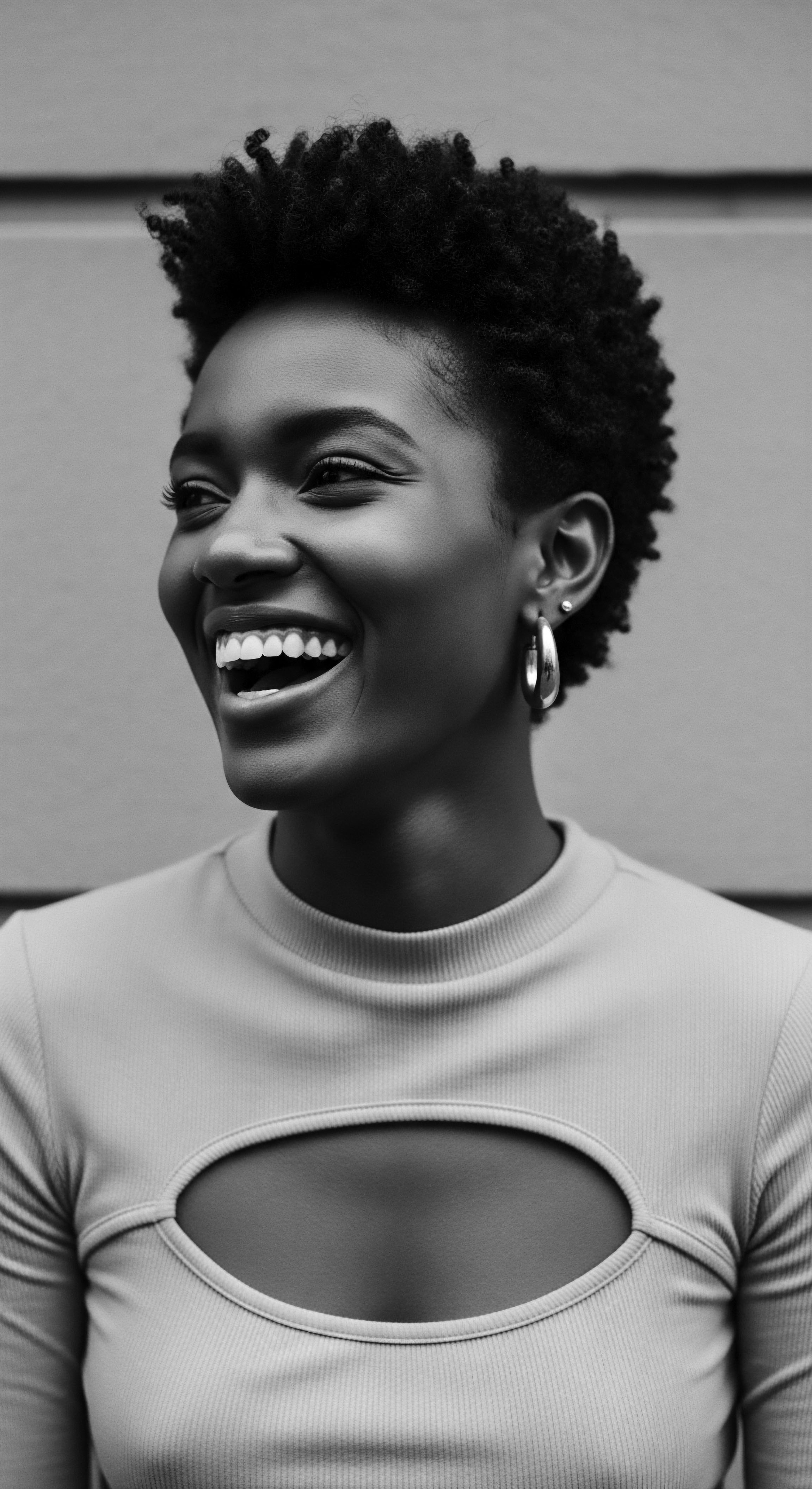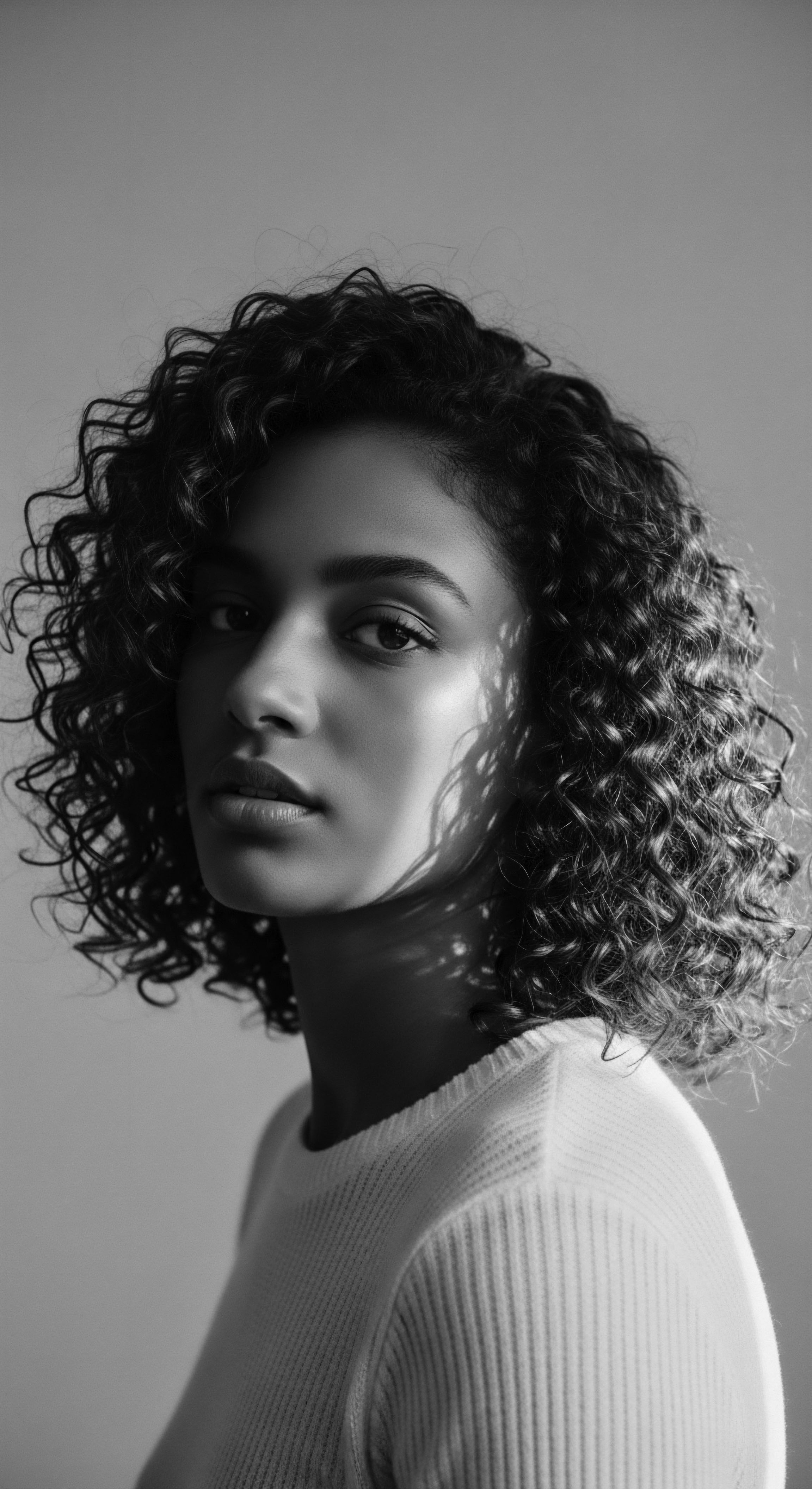
Roots
Beyond the sun-drenched plains and the earth’s ancient rhythms, how did the very strands upon our heads, coiled and robust, withstand the relentless gaze of the sun? This query, so elemental, beckons us toward a contemplation of heritage, a deep reckoning with the genius encoded within textured hair and the wisdom of those who lived in intimate reciprocity with the land. Their understanding, honed over countless generations, perceived hair not merely as adornment, but as a living shield, an extension of self intricately bound to the cosmos and its elements. Before the advent of modern dermatological discourse, the very architecture of textured hair, particularly those coiling strands often seen across African lineages, offered an intrinsic defense.
The tightly wound helix of melanin-rich hair, a masterpiece of biological engineering, provided a dense canopy. This natural design creates a protective barrier, limiting direct solar penetration to the scalp, thus shielding it from harmful ultraviolet radiation.

Melanin’s Ancient Guardian Role
Consider the profound role of melanin, that vital pigment coloring our skin and hair. In textured hair, especially those deep, dark hues, the concentration of eumelanin is often substantial. This dark pigment acts as a natural absorber of ultraviolet rays, converting radiant energy into heat and dissipating it safely. Scientific studies confirm that hair with higher eumelanin content offers enhanced photoprotection compared to lighter hair.
This biological reality served as an initial validation for ancestral communities; they observed and intuitively understood the inherent fortitude of their hair against the sun’s ardor. The hair’s natural shade, then, was not merely a matter of beauty, but a testament to its protective capability against harsh environments.

Hair’s Coiled Architecture and Climate Adaptation
The unique coiled structure of textured hair is an extraordinary adaptation to climates marked by intense solar exposure. Each individual coil, multiplied across the scalp, creates a dense, multi-layered cushion. This acts as a natural insulator, regulating scalp temperature by trapping a layer of air between the hair and the skin. This air pocket mitigates direct heat transfer from the sun, keeping the scalp cooler than a bare or lightly covered head.
Such an evolutionary response, honed over millennia in equatorial regions, speaks to an innate resilience woven into the very being of textured hair. It was a silent, powerful validation from the earth itself, confirming hair’s capacity to withstand the sun’s force.
Textured hair, particularly those deep, dark hues, possesses an inherent sun-shielding quality due to its melanin content and coiled architecture.

An Evolutionary Heritage of Resilience
The very presence of highly textured hair in populations originating from sun-intensive regions points to an evolutionary heritage of solar defense. Early human ancestors living in environments with strong solar radiation developed this hair type as a survival mechanism. The thick, spiral-shaped curls provided crucial protection for the scalp, allowing for effective thermoregulation and defense against the sun’s constant presence.
This ancestral legacy is perhaps the earliest, most powerful validation of textured hair’s resilience against solar damage, long before any human hand ever reached for a protective salve or fashioned a woven shield. The hair itself became a first line of defense, a living umbrella.
| Melanin Type Eumelanin |
| Hair Color Brown to Black |
| UV Protection High absorption, strong defense against UV rays. |
| Melanin Type Pheomelanin |
| Hair Color Yellow to Red |
| UV Protection Lower absorption, reduced inherent defense. |
| Melanin Type The presence and concentration of eumelanin provide natural solar defense for textured hair. |

Ritual
The dialogue between textured hair and the sun, though rooted in biology, found its narrative in the ancient rituals of care. Ancestral communities, acutely attuned to their environment, recognized the sun’s power and responded with practices that fortified their hair’s natural strengths. These were not merely acts of grooming; they were ceremonies of protection, acknowledgments of hair’s vitality and its sacred connection to both body and spirit. From the application of earthen pastes to the thoughtful shaping of styles, indigenous methods revealed a sophisticated understanding of environmental interaction and hair preservation.

Protective Styles as Living Shields
The diverse world of protective styling stands as a testament to ancestral ingenuity in managing solar exposure. Braids, twists, and elaborate coiffures were not only expressions of social standing, marital status, or spiritual belief; they served a practical purpose. By gathering and securing the hair, these styles minimized the surface area exposed to direct sunlight, thus reducing the risk of dehydration and solar impact on individual strands.
Think of the intricate cornrows that graced heads across West Africa, or the meticulously styled buns and wrapped looks seen in various Indigenous American nations. These were living, breathing shields, crafted with purpose and deep cultural meaning.
Across many African and Indigenous American cultures, head coverings held similar significance. Scarves and wraps, often woven from natural fibers, served as additional layers of protection. Beyond their aesthetic appeal and spiritual symbolism, these coverings provided a direct barrier against the sun’s relentless gaze.
They ensured that even when exposed to prolonged daylight, the hair remained shielded, its moisture guarded within the confines of the wrapping. This practice speaks to a profound respect for hair’s vulnerability and an inherited wisdom for its care.

Plant-Based Elixirs for Sun Defense
The earth offered a boundless pharmacy, and indigenous peoples possessed the profound knowledge to interpret its remedies. They understood that certain plant-based ingredients could enhance hair’s resilience against the sun. Oils extracted from nuts and seeds, rich in fatty acids and vitamins, were mainstays.
Shea butter, sourced from the karite tree in West Africa, was widely used to seal moisture into hair and skin, forming a protective barrier against environmental aggressors, including the sun. Similarly, mongongo oil, drawn from the nuts of the Kalahari Desert’s mongongo tree, was known for its nourishing properties and ability to create a shield against solar impact.
Ancestral communities intuitively understood the sun’s power, responding with intricate styles and plant-based elixirs to fortify hair’s innate strengths.
Other botanical preparations offered specific benefits. Aloe vera, a succulent plant found in many hot climates, was applied for its soothing and hydrating qualities, offering a shield from arid conditions and sun exposure. Rosemary, a familiar aromatic herb, was recognized for its ability to strengthen hair and protect against dullness brought on by solar intensity. These applications, passed down through oral tradition and practical demonstration, revealed a deep empirical validation of these plants’ efficacy in maintaining hair health under taxing environmental conditions.
- Shea Butter ❉ A staple in West African communities, renowned for its moisturizing and sun-protective qualities.
- Mongongo Oil ❉ Valued by the iKung tribe, forms a protective barrier against solar damage.
- Aloe Vera ❉ Utilized in many indigenous cultures for its soothing, hydrating, and sun-shielding benefits.
- Bear Grease ❉ Employed by some Native American tribes as a pomade and hair dressing to guard hair.

Did Traditional Methods Offer Holistic Conditioning against Solar Effects?
Traditional practices often approached hair care with a holistic perspective, acknowledging the interconnectedness of hair health with overall wellbeing and environmental factors. The continuous application of natural oils and butters, often combined with various herbs, served not only to protect against solar damage but also to condition the hair, preventing dryness, breakage, and maintaining its pliability. These were not singular treatments, but consistent regimens that reinforced hair’s structural integrity.
The use of certain clays, such as those mixed with red ochre by the Himba women of Namibia, created a physical coating, adding another layer of defense against direct solar radiation while also conditioning the hair and scalp. This layered approach, combining natural biological protection with external applications and mindful styling, speaks to a sophisticated and deeply ingrained understanding of hair’s needs in sun-drenched environments.

Relay
The dialogue between hair and sun, whispered through ancient practices, finds its continuation in the revelations of contemporary science. Today, we stand at a unique intersection, where the wisdom of ancestral care can be illumined and, at times, explained by the precise language of modern research. The resilience of textured hair against solar damage is not solely a matter of historical account; it is a living phenomenon, its mechanisms continually affirmed by scientific inquiry, allowing us to relay these insights across generations.

How do Ancestral Remedies Align with Contemporary Scientific Understanding of Hair’s Resilience?
The intrinsic solar resistance of textured hair, particularly those with higher eumelanin concentrations, finds strong support in modern photobiology. Eumelanin, the brown-black pigment, demonstrates superior photostability and UV absorption capabilities compared to pheomelanin, which colors lighter hair. This explains why dark hair naturally absorbs more radiation across various wavelengths, offering more protection from solar damage than lighter hair types. Research by de Gálvez et al.
(2015) established a “Hair Ultraviolet Protection Factor” (HUPF), quantifying the protective effect of hair density, thickness, and melanin content against UV radiation. This study confirmed that hair acts as a significant natural barrier, especially dense, dark hair. This scientific finding directly correlates with the observed resilience of textured hair in historically sun-exposed populations, providing a contemporary validation for ancestral experiences.
The protective qualities of natural oils and plant extracts, long utilized in indigenous hair care, are now being explored and affirmed through scientific lenses. Many traditional oils, such as mongongo oil, are rich in polyunsaturated fatty acids and vitamin E, components known for their antioxidant properties and ability to form protective barriers. These elements can help mitigate the oxidative stress and lipid degradation caused by UV radiation, which leads to issues like dryness and brittleness.
Similarly, plant extracts like aloe vera, rosemary, and specific Sri Lankan medicinal plants have shown antioxidant activity and photoprotective potential in modern studies. These scientific affirmations lend a new dimension to ancestral practices, demonstrating that empirical observations were grounded in tangible, beneficial effects.
The deep wisdom of ancestral practices for hair preservation consistently finds affirmation within modern scientific inquiry.

Sun’s Impact on Hair’s Core Components
Solar radiation inflicts damage on hair’s primary components ❉ proteins, lipids, and melanin itself. UV rays can break down keratin, the main protein structure of hair, leading to reduced tensile strength and increased brittleness. Lipids, which contribute to hair’s natural sheen and flexibility, can undergo oxidation, resulting in a duller, coarser texture. Even melanin, while protective, can decompose under prolonged exposure, causing lightening or color changes.
This scientific understanding of solar degradation underscores the historical need for protective practices, reinforcing the ancestral intuition that hair required diligent safeguarding against the sun’s pervasive influence. The various indigenous applications of plant-based materials and strategic styling were direct responses to these forms of environmental stress.
| Traditional Practice Coiled Hair Texture |
| Scientific Principle Affirmed Natural insulation, UV barrier, thermoregulation. |
| Heritage Context Evolutionary adaptation for survival in hot climates. |
| Traditional Practice Use of Plant Oils/Butters |
| Scientific Principle Affirmed Antioxidant action, lipid barrier reinforcement, moisture retention. |
| Heritage Context Ancestral reliance on local flora for hair health and protection. |
| Traditional Practice Protective Hairstyles |
| Scientific Principle Affirmed Reduced surface area exposure to UV, physical barrier. |
| Heritage Context Cultural expression, social markers, and practical environmental adaptation. |
| Traditional Practice The enduring efficacy of ancestral hair care methods is increasingly validated by modern scientific understanding. |
The synergy between ancestral wisdom and contemporary science reveals a circular knowledge path. What was once understood through generations of observation and lived experience—the efficacy of a particular oil, the strength offered by a specific braid—is now, in many instances, illuminated by biochemical analyses and quantified measurements. This scientific validation helps us more fully appreciate the intricate foresight embedded within textured hair heritage, underscoring its historical importance and its continued relevance in a world still bathed in sunlight.

Reflection
The stories of textured hair’s resilience against the sun are not confined to dusty archives; they pulse with the vitality of generations, a living testament to ancestral wisdom. We have traced a journey from the very helix of the hair strand, discovering its innate defenses, to the intricate rituals of protection crafted by indigenous hands. These practices, born of necessity and deep environmental attunement, speak to a profound reciprocity with the earth, where understanding flowed from observation and care stemmed from reverence. Each braid, each application of plant butter, each carefully draped cloth, echoed a sacred commitment to hair’s wellbeing, recognizing its role as a spiritual anchor and a cultural marker.
The resilience of textured hair, often tested by historical hardships, stands as a symbol of enduring spirit. Its ability to shield against solar damage, validated first by millennia of lived experience and now by modern scientific inquiry, reminds us that the past is not separate from the present. It is a continuous stream, offering timeless lessons for holistic health and identity.
The Roothea ethos, which sees the “Soul of a Strand” as a living archive, finds its heart in this ongoing discovery. By honoring these ancestral pathways, we not only preserve a rich heritage but also illuminate a sustainable path forward for textured hair care, one that acknowledges the sun’s embrace while safeguarding our crowns with inherited wisdom.

References
- de Gálvez, M. V. Aguilera, J. Bernabó, J.-L. Sánchez-Roldán, C. & Herrera-Ceballos, E. (2015). Human Hair as a Natural Sun Protection Agent ❉ A Quantitative Study. Photochemistry and Photobiology, 91(4), 966-970.
- Daud, F. S. & Kulkarni, S. B. (2011). Comparative evaluation of photo-protective effect of Aloe vera Tourn. ex Linn. on UV damage in different Asian hair types. Indian Journal of Natural Products and Resources, 2(2), 179-183.
- Napagoda, M. Ediriweera, M. K. & Rathnasooriya, H. D. (2021). Ethnopharmacological Survey on Medicinal Plants Used for Cosmetic Treatments in Traditional and Ayurveda Systems of Medicine in Sri Lanka. Evidence-Based Complementary and Alternative Medicine, 2021.
- Byrd, A. & Tharps, L. L. (2001). Hair Story ❉ Untangling the Roots of Black Hair in America. St. Martin’s Press.
- Goddard, N. (2020). Melanin for Hair ❉ What Role It Plays & How to Increase Production. Healthline.
- Hoting, A. (1997). The Chemistry of Hair Pigmentation. Journal of the Society of Cosmetic Chemists, 48(4), 211-222.
- Malinauskyte, J. (2019). The Impact of UV Radiation on Hair ❉ Damage and Protection. Cosmetics & Toiletries, 134(8), 50-56.
- Okereke, E. (2000). African Hair Care ❉ A History. Xlibris Corporation.
- Robbins, C. R. (2012). Chemical and Physical Behavior of Human Hair. Springer.
- Sies, H. (2014). Carotenoids and Other Plant Pigments as Antioxidants. In Encyclopedia of Human Nutrition (3rd ed. pp. 317-322). Academic Press.
- Stahl, W. Heinrich, U. Aust, O. Tronnier, H. & Sies, H. (2006). Lycopene-rich products and dietary photoprotection. Photochemical & Photobiological Sciences, 5(2), 238-242.
- Suro, L. (2003). African Textiles and Decorative Arts. The Museum of Modern Art.
- Turner, D. & Crawford, D. (2004). Natural Hair Care and the Black Community. University of California Press.
